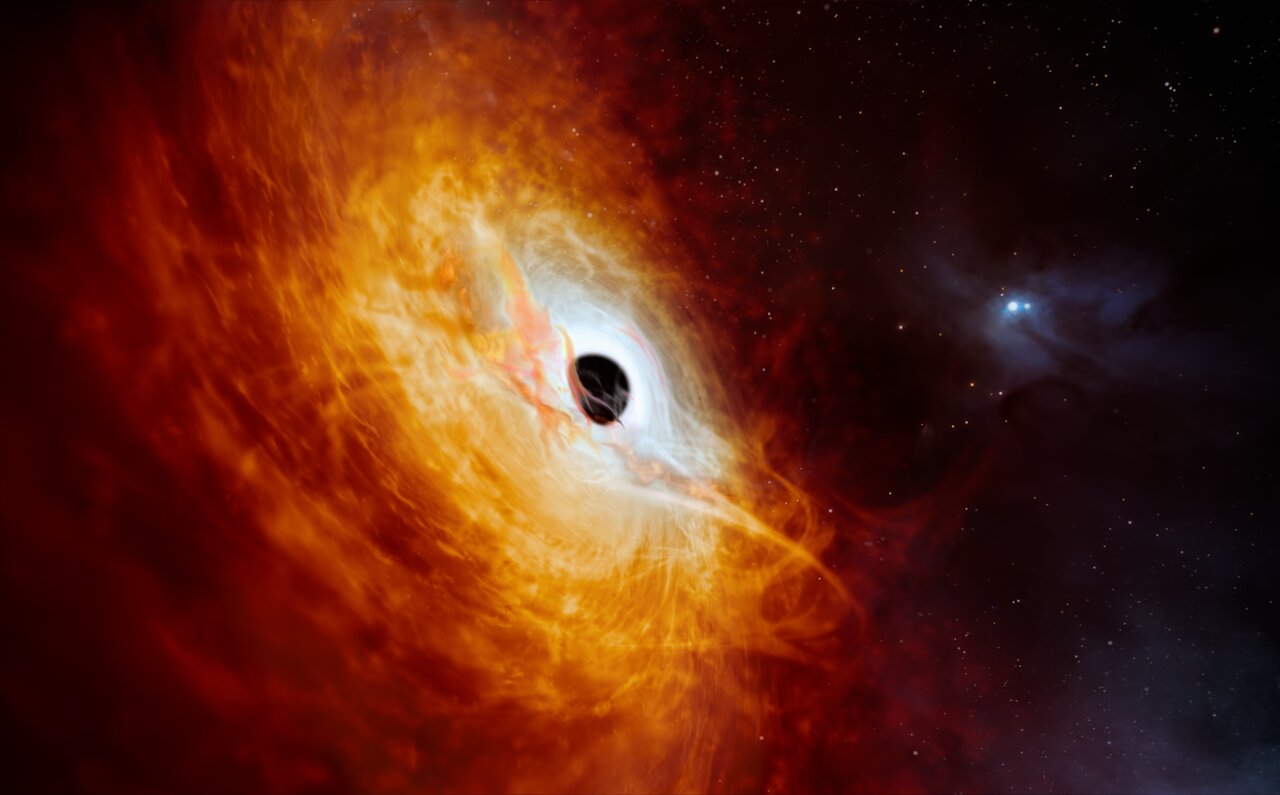It’s an exciting time in astronomy today, where records are being broken and reset regularly. We are barely two months into 2024, and already new records have been set for the farthest black hole yet observed, the brightest supernova, and the highest-energy gamma rays from our Sun. Most recently, an international team of astronomers using the ESO’s Very Large Telescope in Chile reportedly saw the brightest object ever observed in the Universe: a quasar (J0529-4351) located about 12 billion light years away that has the fastest-growing supermassive black hole (SMBH) at its center.
The international team responsible for the discovery consisted of astrophysicists from the Research School of Astronomy and Astrophysics (RSAA) and the Center for Gravitational Astrophysics (CGA) at the Australian National University (ANU). They were joined by researchers from the University of Melbourne, the Paris Institute of Astrophysics (IAP), and the European Southern Observatory (ESO). The paper that describes their findings, titled “The accretion of a solar mass per day by a 17-billion solar mass black hole,” recently appeared online and will published in the journal Nature Astronomy.
First observed in 1963 by Dutch-American astronomer Maarten Schmidt, quasars (short for “quasi-stellar objects”) are the bright cores of galaxies powered by SMBHs. These black holes collect matter from their surroundings and accelerate it to near the speed of light, which releases tremendous amounts of energy across the electromagnetic spectrum. Quasars become so bright that their cores will outshine all the stars in their disk, making them the brightest objects in the sky and visible from billions of light-years away.
As a general rule, astronomers gauge the growth rate of SMBHs based on the luminosity of their galaxy’s core region – the brighter the quasar, the faster the black hole is accreting matter. In this case, the SMBH at the core of J0529-4351 is growing by the equivalent of one Solar mass a day, making it the fastest-growing black hole yet observed. In the process, the accretion disk alone releases a radiative energy of 2 × 1041 Watts, more than 500 trillion times the luminous energy emitted by the Sun. Christian Wolf, an ANU astronomer and lead author of the study, characterized the discovery in a recent ESO press release:
“We have discovered the fastest-growing black hole known to date. It has a mass of 17 billion Suns, and eats just over a Sun per day. This makes it the most luminous object in the known Universe. Personally, I simply like the chase. For a few minutes a day, I get to feel like a child again, playing treasure hunt, and now I bring everything to the table that I have learned since.”
But what was most surprising was that this quasar was hiding in plain sight. “All this light comes from a hot accretion disc that measures seven light-years in diameter — this must be the largest accretion disc in the Universe,” said ANU Ph.D. student and co-author Samuel Lai. “It is a surprise that it has remained unknown until today, when we already know about a million less impressive quasars. It has literally been staring us in the face until now,” added co-author Christopher Onken, who is also an astronomer at ANU.
As Onken explained, J0529-4351 showed up in images taken by the ESO Schmidt Southern Sky Survey dating back to 1980. It was only in recent years that it was recognized as a quasar, thanks to improved instruments and measurements. Finding quasars requires precise observations from large areas of the sky, resulting in massive datasets that often require machine learning algorithms to analyze them. However, these models are somewhat limited because they are trained on existing data, meaning candidates are selected based on previously observed objects.

Since J0529-4351 is so luminous, it was dismissed by the ESA’s Gaia Observatory as being too bright to be a quasar and was ruled to be a bright star. Last year, the ANU-led team identified it as a distant quasar based on observations using the 2.3-meter telescope at the Siding Spring Observatory in Australia. They then conducted follow-up observations using the X-shooter spectrograph on the ESO’s VLT telescope to confirm their results. The quasar is also an ideal target for the GRAVITY+ upgrade on ESO’s Very Large Telescope Interferometer (VLTI), designed to accurately measure the mass of black holes.
In addition, astronomers look forward to making observations with next-generation telescopes like the ESO’s Extremely Large Telescope (ELT). This 39-meter telescope, currently under construction in the Atacama Desert in Chile, will make identifying and characterizing distant quasars easier. Studying these objects and their central black holes could reveal vital details about how SMBHs and galaxies co-evolved during the early Universe.
Further Reading: ESO, ESO Science Papers

